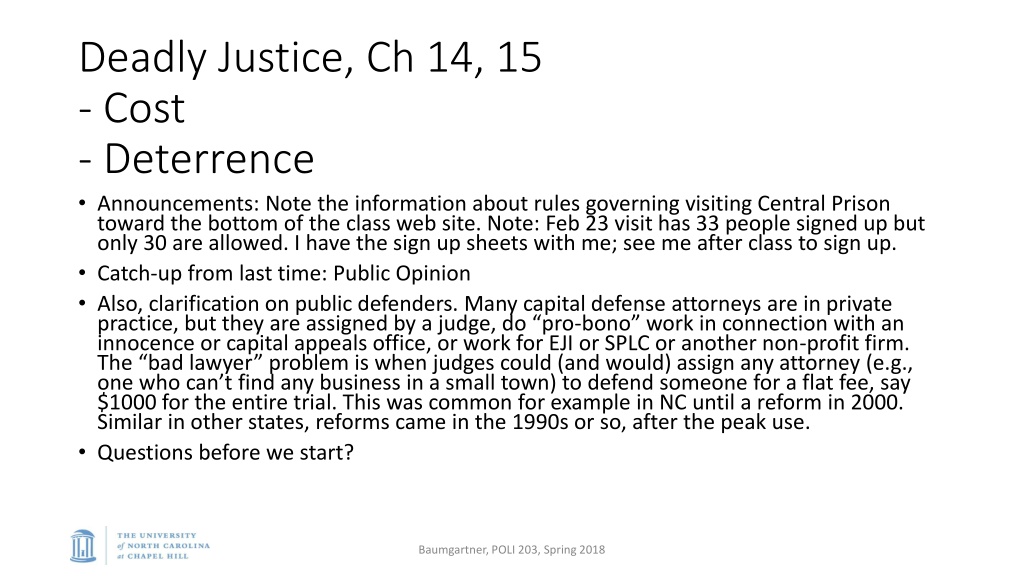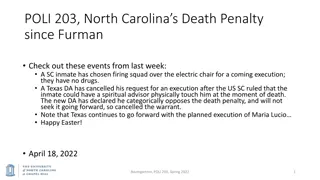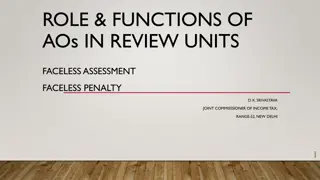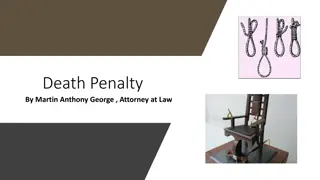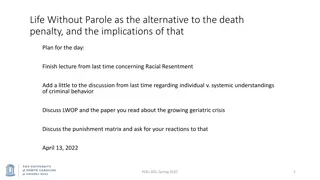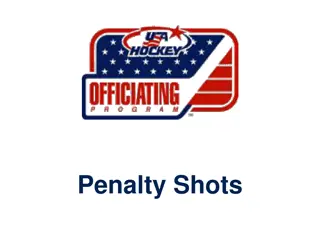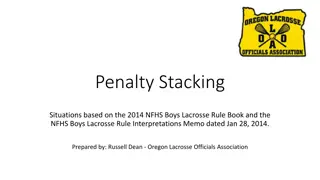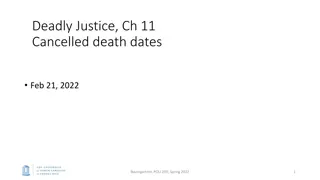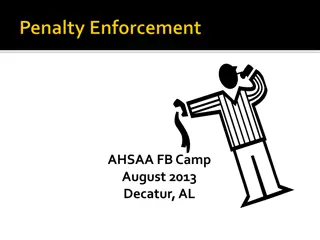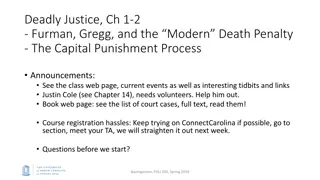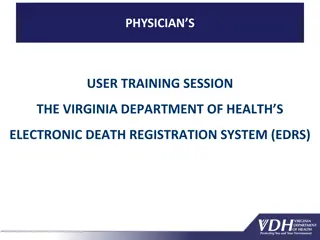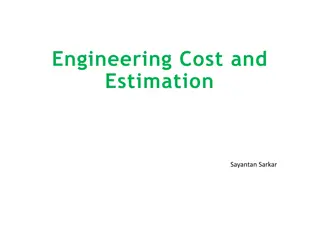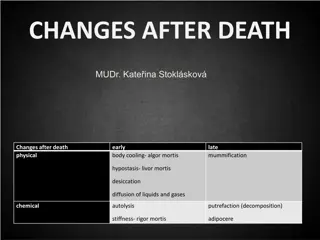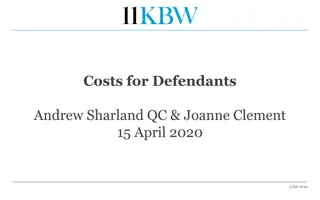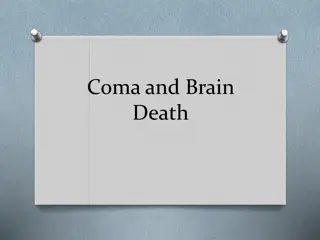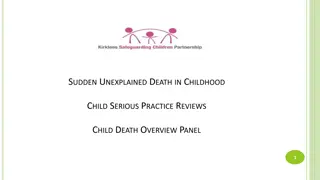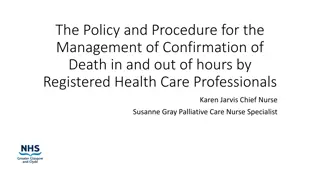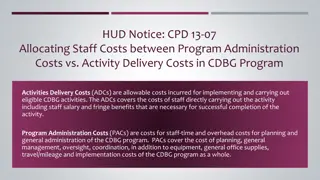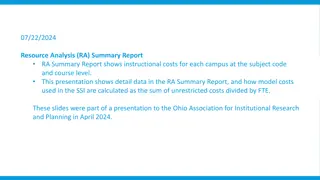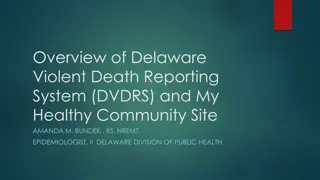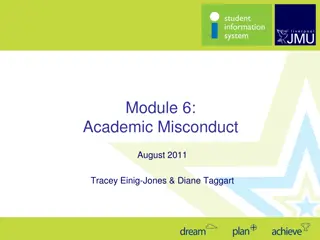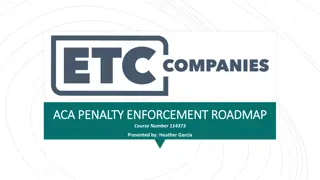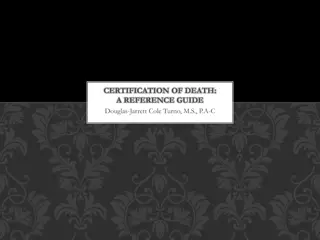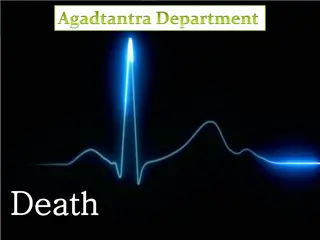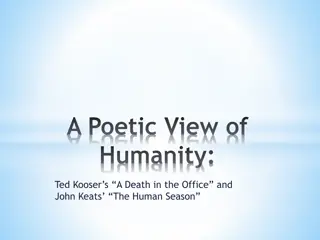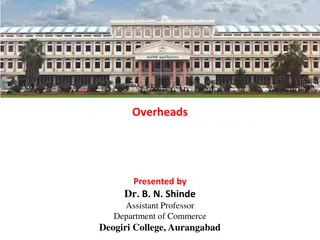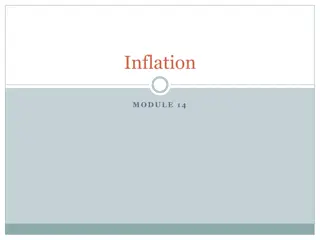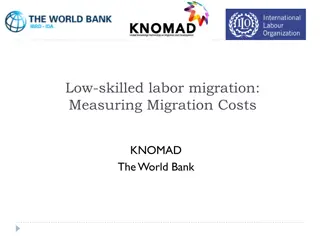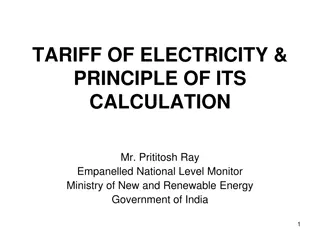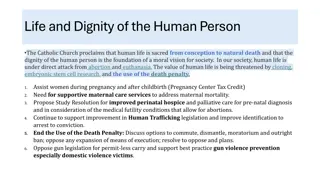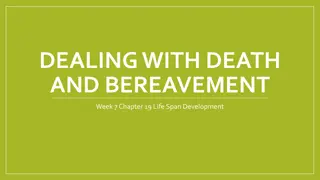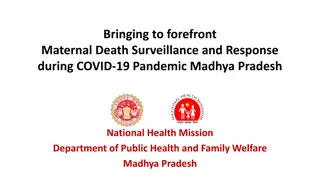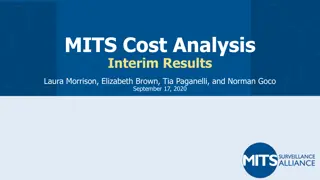Challenges and Costs of the Death Penalty System
The content discusses the high costs associated with the death penalty system, including expenses for trials, appeals, and maintaining death row inmates. It highlights the inefficiencies and financial burdens faced by states like New Jersey, Pennsylvania, California, and North Carolina. Various factors contributing to the substantial costs are explored, alongside suggestions for improving efficiency to reduce expenses.
Download Presentation

Please find below an Image/Link to download the presentation.
The content on the website is provided AS IS for your information and personal use only. It may not be sold, licensed, or shared on other websites without obtaining consent from the author. Download presentation by click this link. If you encounter any issues during the download, it is possible that the publisher has removed the file from their server.
E N D
Presentation Transcript
Deadly Justice, Ch 14, 15 - Cost - Deterrence Announcements: Note the information about rules governing visiting Central Prison toward the bottom of the class web site. Note: Feb 23 visit has 33 people signed up but only 30 are allowed. I have the sign up sheets with me; see me after class to sign up. Catch-up from last time: Public Opinion Also, clarification on public defenders. Many capital defense attorneys are in private practice, but they are assigned by a judge, do pro-bono work in connection with an innocence or capital appeals office, or work for EJI or SPLC or another non-profit firm. The bad lawyer problem is when judges could (and would) assign any attorney (e.g., one who can t find any business in a small town) to defend someone for a flat fee, say $1000 for the entire trial. This was common for example in NC until a reform in 2000. Similar in other states, reforms came in the 1990s or so, after the peak use. Questions before we start? Baumgartner, POLI 203, Spring 2018
Lets do another poll, just to check the system Think about what has surprised you most so far this semester, in terms of the death penalty. Distill that down to one word or phrase. If you use a phrase, write_it_like_this_so_it_appears_as_one_word. Next slide: A word cloud of your responses. Baumgartner, POLI 203, Spring 2018
Cost (with Justin Cole, class of 18) Costs are surprisingly high Not just individual trials Costs must include having the death penalty as an option, for the entire state Savings: Use DP as a plea bargaining tool, have inmate plead to LWOP Less time in prison Expenses Qualified jury, longer trial, more experts, more prosecution resources, more defense attorneys, two-stage trial, automatic appeals Inefficiencies: very high reversal rate, long delays in prison, death rows more expensive Baumgartner, POLI 203, Spring 2018
Some estimates NJ: abolished in 2007; 1982 to 2005: 197 capital trials; 60 death sentences; 10 inmates on death row; zero executions. Total cost of the system: $253 million PA: $800 million, 408 death sentences, 3 executions CA: $4 billion, 13 executions NC: $11 million per year (2005-06 estimate) These numbers should blow your mind. Baumgartner, POLI 203, Spring 2018
We found 21 serious studies Typically focused on one state at a time Some looked at each stage of the process; some made an estimate per case (death v. not death sought); some an annual total for the state; some for the entire modern period since 1973. It would be cheaper if the system were more efficient Reduce appeals Reduce time to execution But these reforms could lead to innocents being executed. So the trends have been to more and more inefficiencies. High reversal rates are expensive. Long delays + low probability of death = very expensive. Baumgartner, POLI 203, Spring 2018
Its expensive to ensure accuracy Trials last longer More experts Bad lawyers, so reforms in the 1990s mandate more resources for the defense, including mitigation experts, two trained attorneys, etc. Death is different jurisprudence from the USSC: more appeals The cost argument is bringing libertarians and small government people to the table. The costs are so so large that you could really think about re- allocating that money to something like police officers on the street, or anything else. Is the death penalty a luxury we cannot afford ? Is this a conversation we should even have? Does cost matter in matters of justice? Should it matter? Baumgartner, POLI 203, Spring 2018
Deterrence Often taken for granted that the death penalty deters. Certainly compared to no penalty at all, being punished would deter But note the real question is compared to the next harshest available punishment, LWOP Does death deter, over and above LWOP? What is the additional penological value of death? Retribution, certainly possible But we d need to argue about if there is an additional deterrence value for death after, say, 25 years in solitary That s the California argument by the federal judge in Jones v. Chappell Baumgartner, POLI 203, Spring 2018
Deterrence How it was used in Furman and Gregg Evidence and studies Where we stand today on deterrence Public opinion Baumgartner, POLI 203, Spring 2018
Furman v. Gregg The lack of deterrent value was laid out as a reason to abolish It can t deter if it is used extremely rarely on a randomly selected handful But in 1975, in the midst of a rise in crime, Isaac Ehrlich published a study in the American Economic Review Price theory raise the price, demand goes down Here: the object being purchased is murder. Raise the price of murder, demand goes down. Homicides from 1933 through 1969 Clearance rate: 89 percent Percent of those charged who are convicted: 43 percent Executions as a percent of previous year s convictions: 3 percent Controls: labor force participation, unemployment, number of young men in the population, income, time trend, percent nonwhite in the population, population size, government spending, police spending. (Think about this study ) Result: 7 or 8 homicides prevented, BUT, significant only at the 90 percent level, caveats Take home: Each execution saves 8 lives!!! Baumgartner, POLI 203, Spring 2018
Controversies Social scientists argued back and forth about this. Erlich s study was cited by the US Solicitor General (Robert Bork) in his argument before the USSC in Gregg v. Georgia. Do we have a moral requirement to execute those who kill? Problem is in evaluating the evidence. Note: Erlich s study was death v. no punishment at all, not death v. LWOP. Baumgartner, POLI 203, Spring 2018
Model Uncertainty and the Deterrent Effect of Capital Punishment (2008) All previous estimates from the literature on how many lives are saved by one execution Note: it looks just like a random bell curve. Note: it has a huge variability. Note: Lots of estimates are negative: what s the morality of that? Each execution leads to more violence? Baumgartner, POLI 203, Spring 2018
National Academy of Sciences review NAS brought together a committee to review the issue 2002 report, then updated in 2014 Conclusion: studies on this topic are not informative The science on this question is clear: we don t know. But note that virtually none of the studies have been psychologically reasonable: from the perspective of the potential killer, do we really think they are considering this? Baumgartner, POLI 203, Spring 2018
Public Opinion People tend to believe in deterrence, or used to. Trend is sharply downward over time. People do cite deterrence as a reason to support or oppose. Retribution, deterrence often the most common pro-DP arguments Decline in belief in the deterrence value is part of the explanation for the decline in DP opinion generally LWOP, another form of the death penalty, has undercut the deterrence argument: which would deter more? 50 years in a cage, until you die of old age, or a rapid execution? Actually, no matter what, those are not the real choices. And potential killers are probably not aware of any of this anyway! Baumgartner, POLI 203, Spring 2018
